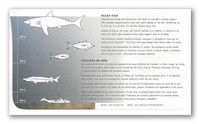
| Name | Value |
|---|---|
| Date of Issue | May 30, 1997 |
| Year | 1997 |
| Quantity | 2,500,000 |
| Denomination |
45¢
|
| Perforation or Dimension | 12.5 x 13 |
| Series | Ocean Water Fish |
| Series Time Span | 1997 |
| Printer | Ashton-Potter Canada Limited. |
| Postal Administration | Canada |
| Condition | Name | Avg Value |
|---|---|---|
|
M-NH-VF
|
Mint - Never Hinged - Very Fine | View price |
|
U-VF
|
Used - Very Fine | View price |
The hidden date for this stamp can be found in the top-left corner.




Upon his return to England in 1497, John Cabot reported that fish were so abundant in the waters of North Atlantic (of what is now Newfoundland), one could fold up the nets and retrieve a catch by simply dipping a basket into the sea. By the 16th century, hundreds of ships and thousands of men were drawn by the North American cod and whale fisheries. The fish brought the fleets that resulted in the settlement of Newfoundland and the establishment of numerous villages in the Maritimes. Since then, fishing has remained a vital industry in Canada, and the fish who inhabit our ocean waters have become part of our heritage. Celebrating that heritage, our new Ocean Water Fish stamps celebrate four of the creatures that swim the waters off the Canadian coastline. Collectors will be interested to know that the official first day cover for the Ocean Water Fish stamps will be postmarked in Alberton PEI - the site of the largest great white shark caught in Canadian waters, measuring 5.26 metres in length. Marking a splash on the issue day of May 30, 1997 in a set of four domestic-rate stamps are the great white shark, bluefin tuna, Pacific halibut and Atlantic sturgeon. Ocean enthusiasts of all ages will be impressed with the realism of these stamps. The 1997 Ocean Water Fish stamp design is by Q30 Design Inc. of Toronto, whose earlier stamp work includes the Holocaust stamps and the High Technology stamp set. The selection of the fish was a difficult task but even larger challenge came from the decision to use actual underwater photographs. Although it was extremely difficult to find underwater photographs that were sharp and clear enough to be reproduced in postage stamp size, the design team knew that photography was the best way to convey the qualities of the fish. And the results are stunning. Halibut are flatfish and flatfish undergo some interesting physical mutations during the course of their lives. With bodies orientated "normally" at birth, they soon roll onto one side, turning half their bodies to the ocean floor. The eye on the downturned side then gradually migrates around to the top of the head and the cranium becomes twisted. As with all flatfish, the body of the Pacific halibut (Hippoglossus stenolepis) is strongly compressed, diamond shaped and highly asymmetrical. The upper or eye side is blackish, dark brown or grey with paler markings and the blind side is normally white. Pacific halibut female grow considerably faster than males, maturing at 12 years of age with a life span of at least 15 years. A large female can produce over 4 million eggs annually. They spawn in the wintertime, and the Pacific halibut will migrate over 1,600 km to produce its eggs. Pacific halibut feed on crab, clams, squid and fish. They are commonly caught on longline or Danish seines.